14 Health Benefits of Shavasana and How to Do It?
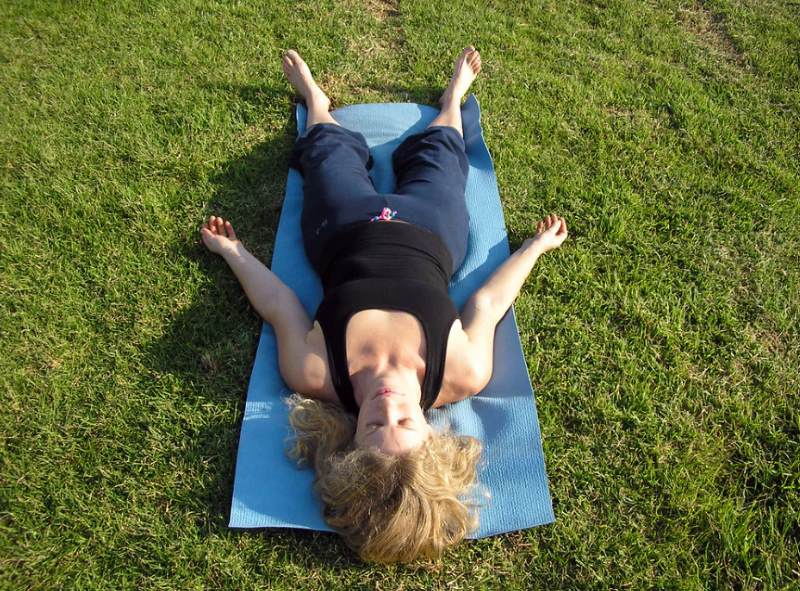
Every exercise has some profound effect on your body. Whether you do sun salutations, cycling, or HIIT classes, it makes your heart beat faster, your lungs breathe in more air, and your body sweat more profusely. However, one such yoga pose, Shavasana, aims to relax your body and mind.
Shavasana, in particular, has benefits that go beyond the body. It is a calming yoga posture that is relatively simple for all.

Table of Contents

What is Shavasana?
In this fast-paced world, people barely sit back and relax. However, yoga can help re-energise people and improve all problem areas in the body and mind. The Shavasana yoga pose helps people relax at the end of a yoga session, allowing them to cool down, lie face up, and be aware of their inner selves.
Shavasana is the Sanskrit name for an essential restorative asana. It is the final resting pose that individuals perform at the end of almost every yoga practice. This yoga brings its type of rest, relaxation and calmness. The word comes from the Sanskrit words 'Sava', which means corpse and 'asana', which means posture.
How to Perform Shavasana (Corpse Pose)?
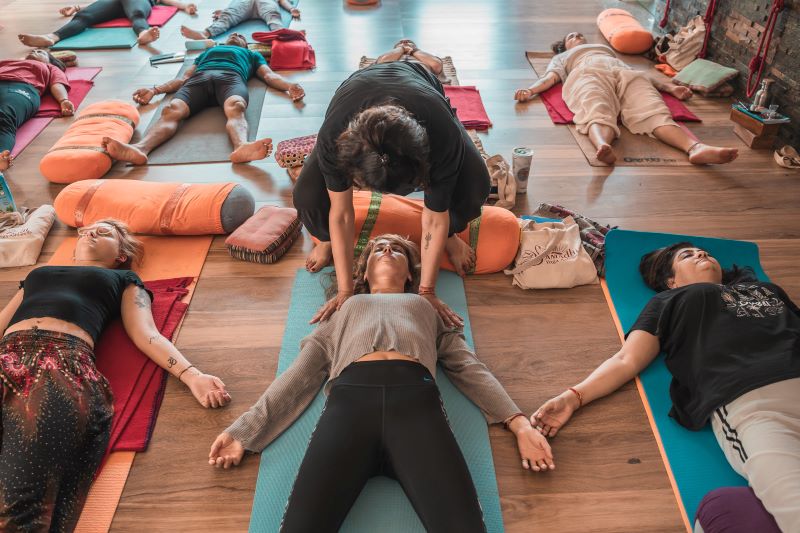
You need to follow the steps below to perform this super easy yoga pose:
Step 1: Lay down on your back, either on the floor or on your yoga mat. This basic meditation pose in Shavasana ensures you are not disturbed for the next 15 minutes after lying down.
Step 2: Close your eyes gently.
Step 3: Relax and place your feet at a comfortable distance apart.
Step 4: In the next step, keep your arms straight along your body. Keep your palms facing up while keeping your arms slightly away from your torso.
Step 5: Focus on your toes and observe them. While doing this, take deep breaths through your nose and exhale slowly.
Step 6: Continue deep breathing while slowly shifting your attention from your toes to the top of your head.
Step 7: Your mind may wander. If so, gently bring it back to your body.
Step 8: Ensure you do not fall asleep while performing this exercise.
Step 9: After about 10 to 12 minutes, you will start to feel relaxed, then slowly roll over to one side and sit up.
Step 10: Now, you can slowly open your eyes while turning your attention outwards.
14 Health Benefits of Shavasana
Shavasana provides numerous health benefits to those who perform it. Knowing its benefits can motivate you to add this pose to your routine. The following are the benefits of Shavasana individuals can get by regularly doing it:
1. Improves Mental Health
One advantage of Shavasana is that it allows you to focus on your breathing and helps you relax your body. This will help you increase your overall mindfulness and mental health.
2. Improves Memory
Shavasana improves memory and concentration. It also helps you focus and recall things better. Practising Shavasana is essential for students and older people.
3. Lowers Blood Pressure
This asana is highly beneficial for people with hypertension, as it helps lower blood pressure by relaxing the body, which drops the heart rate.
4. Helps Relieve Insomnia
Most individuals find that Shavasana helps provide a restful and good night's sleep. People having insomnia but do not want medications can try this pose.
5. Helps in Relaxing the Body
The main objective of the Shavasana pose is to help the body to unwind and relax. Therefore, individuals need to end their high-intensity workout with this pose as it works as a buffer between their workout routine and daily life.
6. Impacts Nervous System
The corpse pose benefits your nervous system by activating the parasympathetic nervous system.
7. Aligns Your Mind
One spiritual benefit that Shavasana provides your body is that it helps align your mind with your body's energies. Therefore, this pose makes you aware of the energies surrounding you because your mind and body should ideally align with the universe.
8. Manages Diabetes
Practising Shvasana can help reduce stress, which is a major pathogenic factor in the development of diabetes. Stress triggers the oxidation process at the lipid membrane level, which aids in the tissue's oxygen release and results in hypoxia.
9. Manages Depression
People’s stress levels significantly changed after doing Shavasana. This could be because breathing and stretching produce endorphins, which lessen physical tiredness and help people feel in the present.
10. Gives a Feeling of Relaxation
The last resting position is achieved by doing active asanas that require expanding the chest or airways, stretching the muscles, and letting go of tension. Shavasana stance for more than fifteen minutes helps the body release tension and become more relaxed
11. Enhanced Energy Levels
Despite its calming nature, Shavasana can boost energy levels by providing deep rest and rejuvenation. Allowing the body and mind to recharge can leave practitioners feeling refreshed and revitalised.
12. Emotional Balance
Shavasana promotes emotional balance by encouraging the release of tension and pent-up emotions. Creating space for inner reflection and introspection can help process emotions and foster a sense of inner peace and equilibrium.
13. Stimulation of Digestion
Although Shavasana is a passive pose, the deep relaxation it induces can stimulate digestion and improve gut health. Reducing stress and promoting relaxation help relieve digestive issues such as indigestion and bloating.
14. Improved Concentration
Shavasana enhances mental clarity and concentration by calming the mind. By letting go of distractions and focusing on the present moment, practitioners can improve their ability to concentrate and focus on tasks.
The Mudras of Shavasana (Corpse Pose)
Mudras can deepen relaxation and focus in Shavasana. Each mudra channels energy and enhances the meditative state, making it more than just physical relaxation but also a mental and spiritual practice.
Here are some mudras commonly used:
1. Anjali Mudra (Prayer Gesture)
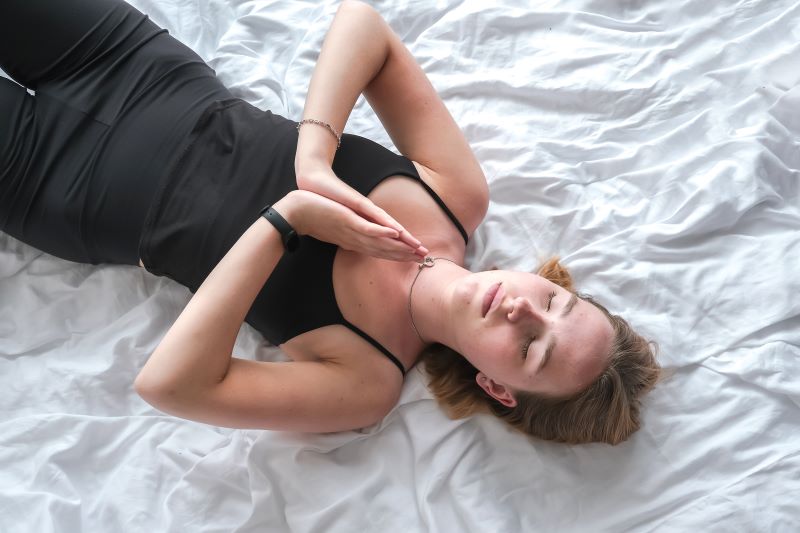
Place the palms together at the centre of your chest while in the Shavasana position. This can enhance the sense of balance and harmony, help quiet the mind, and deepen relaxation.
Benefits of Anjali Mudra: This mudra in the Shavasana pose helps bring focus inwards and encourages balance while relaxing your intuitions.
2. Chin Mudra (Consciousness Gesture)
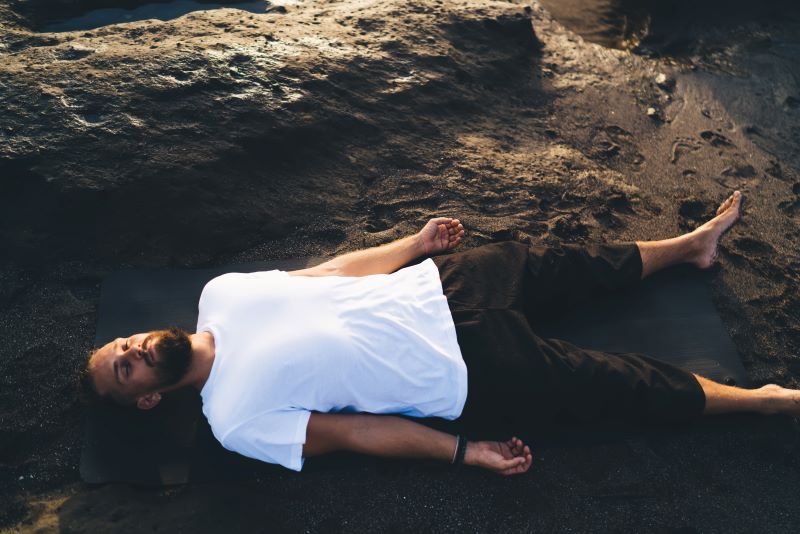
Joining the tip of the thumb and index finger while resting the hands on either can promote inner peace and mental clarity, enhancing the meditative aspect of Shavasana.
Benefits of Chin Mudra: Chin mudra helps to regulate blood pressure and manage stress and depression levels.
3. Adi Mudra (Primordial Gesture)
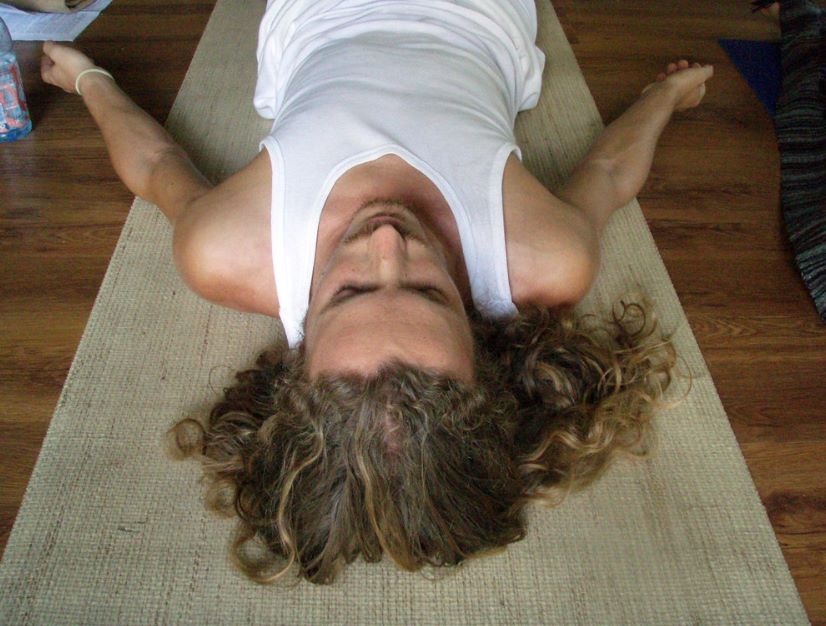
Curling the fingers into the palm and placing the thumbs over them can help draw inward energy and quiet the mind, allowing for a deeper state of relaxation.
Benefits of Adi Mudra: Adi mudra guides energy flow to various body parts, thereby decreasing blood sugar levels and increasing lung capacity.
4. Shunya Mudra (Gesture of Patience)

Connecting the tip of the middle finger and thumb while keeping the other fingers extended can promote patience and inner strength, aiding in surrendering to the present moment during Shavasana.
Benefits of Shunya Mudra: Shunya mudra helps improve balance and reduce hearing loss and tinnitus (ringing in the ears).
Types of Shavasana
There can be a few types of Shavasana to practice. First, select what suits your position best, depending on your expertise and needs. Here are
1. Prone Shavasana

Lie on your belly with your head resting on your hands and elbows bent out. If you need support, keep a pillow under your torso. Your legs can be neutral or slightly turned out, spaced anywhere from a hip bone distance apart to wider than your mat.
2. Side-Lying Shavasana
Lie on your side with your knees bent and stacked. Prop your head with a folded blanket or pillow. Rest your arms comfortably, one along your body or on a bolster.
3. Elevated Shavasana

Lie before a chair or sofa and prop your feet on its edge. This position will lift your waist while keeping your upper back and head flat on the floor. The arms can rest down at a 45 to 60-degree angle from the sides of your body.
4. Bent Leg Shavasana
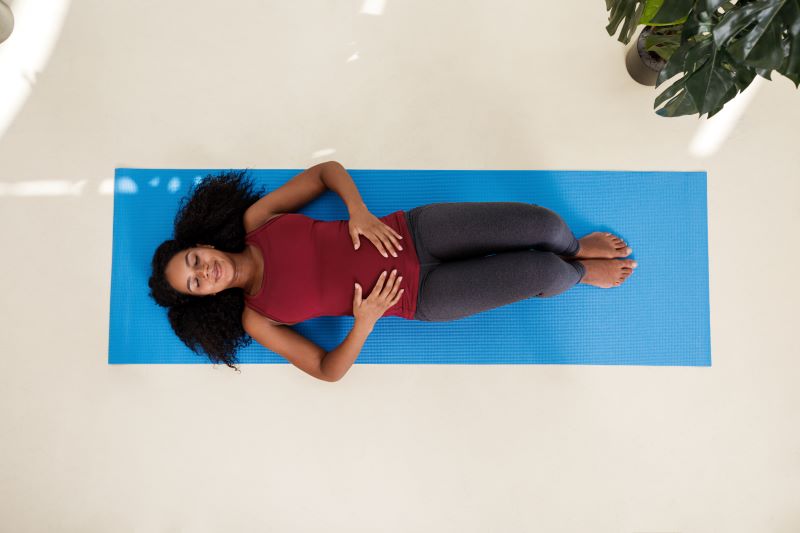
Also known as Constructive Rest Pose, it involves bending the knees in a corpse position. This position assists in compressing the lower back further into the ground, promoting good vertebrate alignment and releasing excess strain and stress.
Things to Know Before Doing Shavasana Yoga
Practitioners must know some crucial aspects before beginning Shavasana. Knowing when and how to do this yoga pose is important to getting the most out of it.
- Comfortable Clothing: Wear loose, comfortable clothing for easy movement and relaxation. This helps you feel more at ease during the practice.
- Quiet Environment: Find a calm and peaceful space where you won't be disturbed. Eliminate distractions like phones or loud noises to immerse yourself in the practice.
- Yoga Mat: Lie down on a yoga mat or a soft surface. This provides support for your body and helps you relax more intensely while you’re lying flat.
- Breathing Awareness: Throughout the practice, maintain awareness of your breath. Focus on slow, deep breathing to help calm the mind and body.
- Body Alignment: Lie down on your back with your legs slightly apart and arms resting comfortably by your sides, palms facing up. Close your eyes gently.
- Relaxation Techniques: Before starting, consider using relaxation techniques like deep breathing or progressive muscle relaxation to release tension from the body.
- Mental Focus: As you lie in Shavasana, focus on letting go of thoughts or worries. Allow your mind to become quiet and still, surrendering to the present.
- Duration: Shavasana is typically practised for 5 to 15 minutes, but you can adjust the duration based on your comfort and schedule.
How Long to Hold Shavasana Pose?
The duration of Shavasana depends on the yoga session before it. Before performing Shavasana, it's essential to listen to your body and how much rest it needs.
- Beginners: Start with 5 to 10 minutes of Shavasana. This duration allows beginners to gradually acclimate to the pose's stillness and relaxation without feeling overwhelmed.
- Intermediate Practitioners: Extend Shavasana to around 10 to 15 minutes. With more experience, you can deepen their relaxation and explore a deeper sense of stillness for a more profound understanding.
- Advanced practitioners: Experienced practitioners may choose to spend anywhere from 15 to 30 minutes or more. This extended time allows advanced practitioners to fully integrate the benefits of their practice and cultivate a profound sense of inner peace and stillness.
Regardless of skill level, listening to your body and honouring its needs is critical. If you're new to yoga, start with shorter durations and gradually increase as you become more comfortable. Always remember that Shavasana is about physical relaxation and mental and emotional rejuvenation.
Risks of Overdoing Shavasana
Although Shavasana seems like a harmless and easy-to-do yoga pose, it has disadvantages. To prevent unease due to Shavasana's malpractice, perform this pose carefully within your level of comfort.
- Muscle Stiffness: Prolonged periods of lying still in Shavasana can lead to muscle stiffness, especially in the back and neck. This can result in discomfort and restricted movement, leading to pain.
- Decreased Body Awareness: Overdoing Shavasana may cause a decrease in body awareness. Instead of being present and mindful, you might drift into lethargy or dullness.
- Reduced Energy Levels: While Shavasana promotes relaxation, overdoing it can lead to excessive lethargy and reduced energy levels. You may feel dizzy or sleepy afterwards rather than refreshed and rejuvenated.
- Loss of Focus: Spending too much time in Shavasana can cause a loss of mental focus. Instead of being alert and present, you might become mentally foggy or unfocused.
- Impact on Circulation: Prolonged immobility during Shavasana can affect circulation, leading to numbness or tingling sensations in the limbs. This can be uncomfortable and may impair circulation in the long run.
- Increased Risk of Falling Asleep: While feeling deeply relaxed during Shavasana is normal, overdoing it can increase the likelihood of falling asleep. This can disrupt the practice and diminish its benefits.
- Delayed Progress in Yoga Practice: Overdoing Shavasana can lead to a lack of balance in yoga practice. Instead of progressing towards more profound states of awareness and flexibility, you may need help in a state of passivity and relaxation.
Shavasana should be practised in moderation to reduce the above risks. Before attempting the pose, understand your body's needs and proceed with the position to prevent the above risks.
What are the Tips for Practising Corpse Pose?
Ideally, this is one of the easiest poses that one can try; however, performing it perfectly can be difficult for some. So, here are some tips that you need to keep in mind:
Before trying it out by yourself, opt for expert assistance to gain its intended benefits.
Individuals with neck, shoulder or lower back concerns can keep a pillow either under their knees or bellies.
Ensure the place where you are performing Shavasana is clean and well-ventilated without any distractions.
It is ideal to start slowly and build up steadily. Beginners can start off with a 10-minute session and then gradually increase the duration and frequency.
If the room you are in is very cold, try to carry a blanket or wear a sweater before performing it. This is because it becomes very difficult to relax and focus when your body is cold.
What are the Precautions and Contraindications of the Corpse Pose?
The precautions that one needs to take while performing the corpse pose are:
- Try to avoid any movements while doing this yoga pose, as it can disturb practice and fuel distractions.
- Try to avoid doing this asana in a crowded or, noisy and distracting environment.
- Keep your body warm while doing this yoga.
- If possible, perform this yoga in a dark place while covering your eyes to avoid any kind of distraction.
- The purpose of this yoga is to relax the mind and body after a high-intensity workout session. So, if anyone finds the workout was not enough for Shavasana, then the purpose will be defeated.
- On the other hand, if the body hurts too much for some reason, relaxing by taking the mind away from the body will be very difficult.
- If one is very distracted, one might find it hard to relax and push the body. However, this can cause even more irritation and headache.
- Individuals having severe acidity might find it uncomfortable to lie on their backs as their food pipe might irritate.
- Although the ideal condition is that you should perform this yoga pose on a flat, hard surface, if you are someone with knee, neck or back pain, you should perform this with a cushion or pillow support.
Doctors do not generally suggest performing Corpse Pose if you have any pre-existing diseases, such as heart disease, spinal issues, or recent surgeries. Hence, they recommend treating such conditions before it’s too late. Hence, having a health insurance policy that covers chronic conditions is necessary for individuals. It will help you manage the expenses in case any emergency treatment arises.
Who Should Avoid Doing Shavasana?
While Shavasana is fairly easy for everyone, even those who are not daily yoga practitioners, some should avoid it.
- People with Severe Back Pain: Shavasana involves lying flat on your back, which can increase back pain for some people. The pressure on the spine may worsen discomfort, leading to increased pain and discomfort during the pose.
- Pregnant Women in Later Stages: While Shavasana is generally safe during early pregnancy, it can become uncomfortable or risky in later stages. Lying flat on the back for extended periods can compress the vena cava, a central vein that returns blood to the heart, potentially reducing blood flow to the fetus.
- Individuals with Low Blood Pressure: Shavasana can cause a sudden drop in blood pressure, leading to dizziness or fainting, especially in individuals prone to hypotension. The prone position combined with relaxation techniques may further lower blood pressure, posing a risk for those with already low blood pressure levels.
- People with Respiratory Issues: Shavasana involves deep, relaxed breathing, which may be challenging with respiratory conditions such as asthma or chronic obstructive pulmonary disease (COPD). Lying flat on the back can also compress the chest, making it difficult for some individuals to breathe comfortably.
- Those with Neck Injuries or Strain: Shavasana's relaxed position may strain the neck, especially for those with existing neck injuries or conditions such as cervical spondylosis. People with neck issues may find maintaining the position uncomfortable or even painful, worsening the condition.
- People with Certain Eye Conditions: Some eye conditions, such as glaucoma or detached retina, may worsen with the increased intraocular pressure when lying flat on the back. Individuals with these conditions should avoid Shavasana or modify the pose by propping themselves up to reduce pressure.
- Those with Digestive Issues: Shavasana immediately after eating may cause discomfort or indigestion for some individuals, particularly those with gastroesophageal reflux disease (GERD) or acid reflux. The prone position can allow stomach acid to flow more easily into the oesophagus, leading to heartburn.
What are the Easy Modifications of Shavasana?
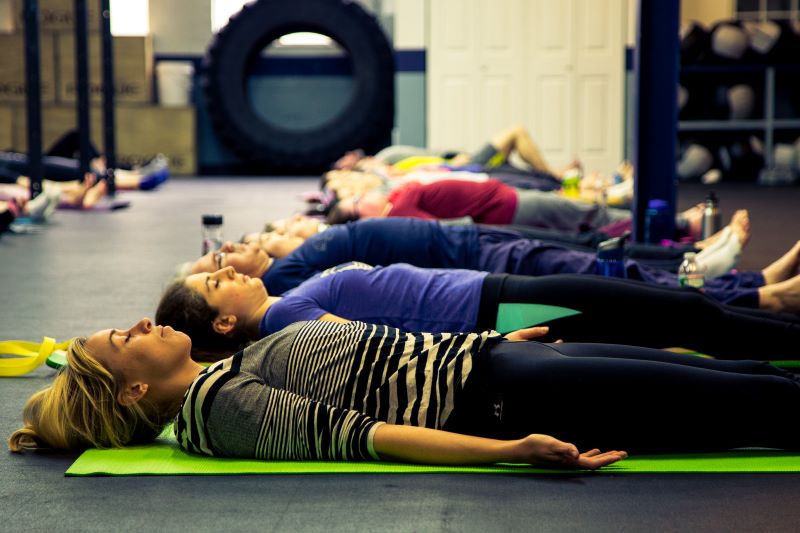
Even though it is one of the simplest yoga poses, you might find it challenging to perform Shavasana, especially if you have pre-existing ailments. Thus, you can bring modifications to this pose by using props and make it more relaxing and comfortable:
To provide better back support, you can raise your knees by placing a blanket or using a bolster below them.
Gather several blankets and bolsters for downward-facing Shavasana. Keep a bolster under your belly and chest, and support your forehead with a blanket or pillow. This will help you get some breathing space, and you can then relax.
So, this is all about the health benefits of Shavasana and why our bodies need it. Amidst the busy lives, most of us lead, we often push ourselves too hard and forget to relax and rejuvenate. In such situations, our bodies develop stress, causing severe anxiety. However, regular exercise and a few minutes of Shavasana can help our bodies rejuvenate, relax, and keep stress away.










